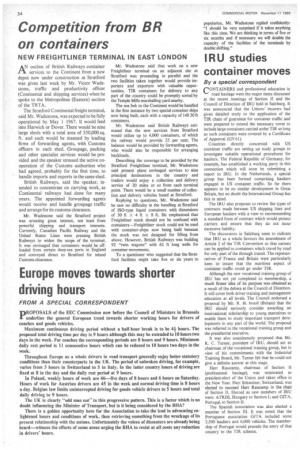Competition from BR on containers
Page 36

If you've noticed an error in this article please click here to report it so we can fix it.
NEW FREIGHTLINER TERMINAL IN EAST LONDON
AI outline of British Railways container services to the Continent from a new depot now under construction at Stratford was given last week by Mr. Victor Wadestone, traffic and productivity officer (Continental and shipping services) when he spoke to the Metropolitan (Eastern) section of the TRTA.
The Stratford Continental freight terminal, said Mr. Wadestone, was expected to be fully operational by May 1 1967. It would feed into Harwich or Dover. There would be nine large sheds with a total area of 350,000 sq. ft. and each would be manned by leading firms of forwarding agents, with Customs officers in each shed. Groupage, packing and other specialist services would be provided and the speaker stressed the active cooperation of the Customs authorities who had agreed, probably for the first time, to handle imports and exports in the same shed.
British Railways, said the speaker, intended to concentrate on carrying work, as Continental railways had done for many years. The appointed forwarding agents would receive and handle groupage traffic and arrange for its customs clearance.
Mr. Wadestone said the Stratford project was arousing great interest, not least from powerful shipping and transport interests. Currently, Canadian Pacific Railway and the United States Lines were pressing British Railways to widen the scope of the terminal. It was envisaged that containers would be offloaded from certain deep-sea ports in England and conveyed direct to Stratford for inland Customs clearance. Mr. Wadestone said that work on a new Freightliner terminal on an adjacent site at Stratford was proceeding in parallel and the two facilities taken together would provide importers and exporters with valuable opportunities. TIR containers for delivery to any part of the country could be promptly sorted by the Temple Mills marshalling yard nearby.
The sea link to the Continent would be handled in the first instance by two special container ships now being built, each with a capacity of 148 30 ft containers.
Mr. Wadestone said British Railways estimated that the new services from Stratford would utilize up to 4,000 containers, of which the railway would provide 25 per cent. The balance would be provided by forwarding agents, who would also be responsible for arranging backloads.
Describing the coverage to be provided by the Stratford Freightliner terminal, Mr. Wadestone said present plans envisaged services to nine principal destinations in the country and traders would enjoy a collection and delivery service of 20 miles or so from each terminal point. There would be a small number of collection and delivery vehicles based at Stratford.
Replying to questions, Mr. Wadestone said he saw no difficulty in the handling at Stratford of ISO-type liquid containers with dimensions of 30 ft x 4 11 X 8 ft. He emphasized that Freightliner stock should not be confused with containers—Freightliner stock could not be used with container-ships now being built because the stock was not designed for lifting from above. However, British Railways was building 92 "twin wagons" with 62 ft long wells for container movements.
To a questioner who suggested that the Stratford facilities might take five or six years to popularize, Mr. Wadestone replied confidently: "I should be very surprised if it takes anything like this time. We are thinking in terms of five or six months and if necessary we will double the capacity of the facilities of the terminals by double shifting."
































































































































